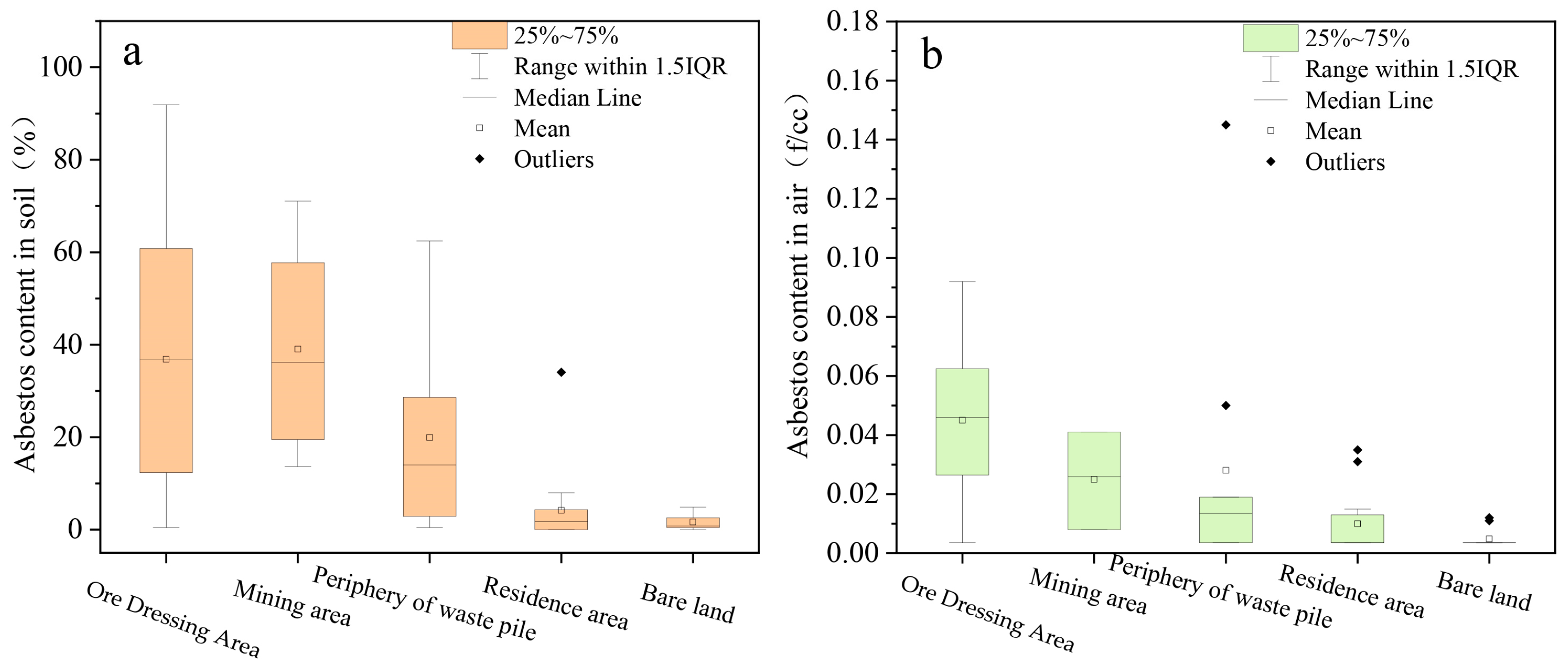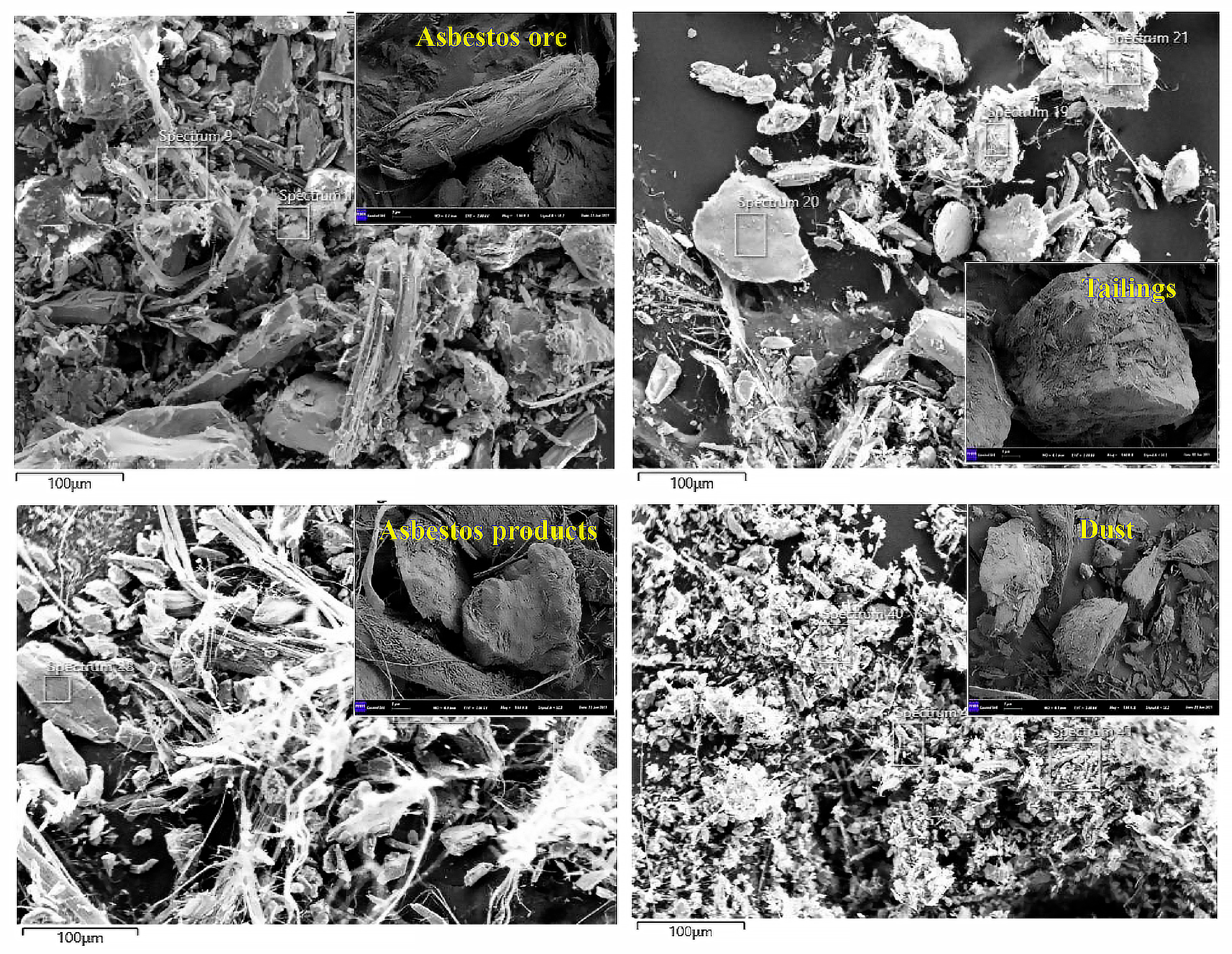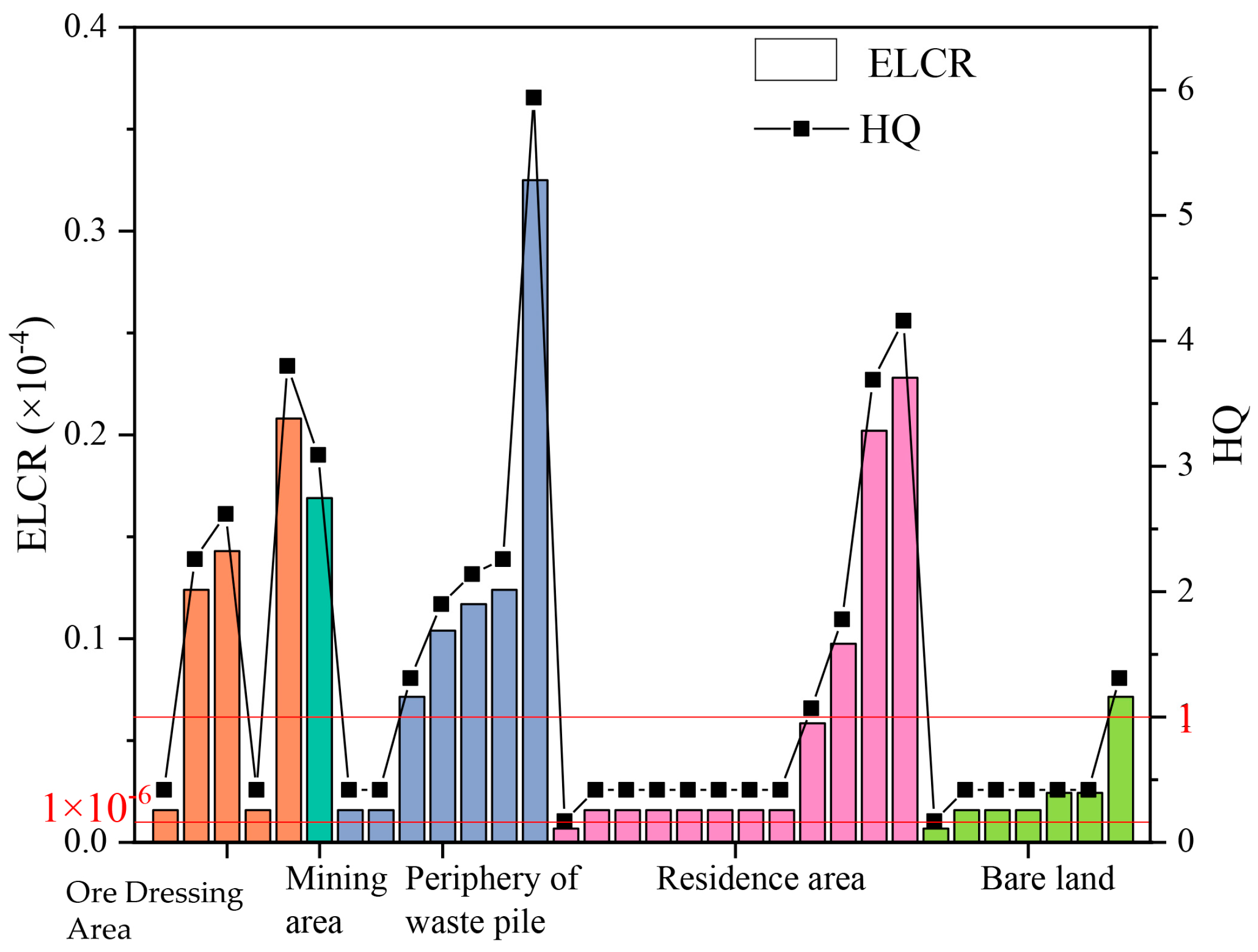Asbestos-Environment Pollution Characteristics and Health-Risk Assessment in Typical Asbestos-Mining Area
Abstract
1. Introduction
2. Materials and Methods
2.1. Overview of Study Area
2.2. Sample Collection
2.3. Analysis and Quantification Method of Asbestos in Air and Soil
- C—Quantitative value of asbestos fiber concentration in the air (f·cc−1);
- A—Dust collection area value of filter membrane (mm2);
- N—The determined total quantity of fibers (f);
- a—Counting of the field of view of the eyepiece’s micrometer (mm2);
- n—The number of visual fields determined by enumeration;
- F—Flow sampling value (L/min);
- t—Sampling time value (min).
2.4. Analysis Method of f Morphological Features of Asbestos Fibres
2.5. Assessment Method for Human Health Risk
- (1)
- Carcinogenic risk assessment
- (2)
- Non-carcinogenic-risk assessment
3. Results and Discussion
3.1. Feature Analysis of Asbestos Contents in Environment Media from Different Areas
3.2. Feature Analysis of Asbesto-Fibre Microtopographies in Different Area Environment Media
3.3. Human-Health Risk of Airborne Asbestos Fibres
4. Conclusions
- (1)
- The soil surface and air in the sampling area has been polluted to different extents. The asbestos concentration on the soil surface in the mining area was the highest, and those in the ore-dressing area and the waste-pile area were ranked second. The ore-dressing area exhibited the highest asbestos air concentration.
- (2)
- The SEM-imaging results showed that the main morphologies of the asbestos were basically strip, short columnar, and granular. The arrangement sequence of the slenderness (length-to-diameter ratio) of the asbestos fibre was as follows, in descending order: asbestos products > asbestos ore > tailings > dust.
- (3)
- The release of asbestos dust close to the dressing and tailing areas directly led to the increase in the concentration of asbestos in the polluted soil. The irregular strip-shaped fibres were agglomerated, such that the profile turned out to be clearer.
- (4)
- The risk-control values in the three scenarios (adults working in offices or living in the mining area, adults’ outdoor activities in the peripheral residentia area, and children’s outdoor activities) reached 0.0084, 0.0090, and 0.0090 f·cc−1, respectively. In total, 40.6% of the sites exceeded the unacceptable non-carcinogenic risk level. Most of the sites exhibiting higher risk indexes were located close to the waste pile in the downwind direction.
Author Contributions
Funding
Data Availability Statement
Conflicts of Interest
References
- Xiaoting, C.; Naiwang, T.; Dengfeng, Z.; Shuiwang, J. Introduction of test methods for asbestos in ship materials. Dev. Appl. Mater. 2014, 29, 79–88. [Google Scholar]
- Long, Z.Y.; Seok, B.H.; Hwa, H.W.; Wook, C.G.; Ha, L.Y.; Chan, K.Y. Risk assessment of asbestos containing materials in a deteriorated dwelling area using four different methods. J. Hazard. Mater. 2020, 410, 124645. [Google Scholar]
- IARC. Asbestos (chrysotile, amosite, crocidolite, tremolite, actinolite, and anthophyllite). In A Review of Human Carcinogens; IARC: Lyon, France, 2012; pp. 219–309. [Google Scholar]
- USEPA. Naturally Occurring Asbestos: Approaches for Reducing Exposure; Office of Superfund Remediation and Technology Innovation: Washington, DC, USA, 2008.
- Virta, R.L. Asbestos: Geology, Mineralogy, Mining, and Uses; US Department of the Interior, US Geological Survey: Washington, DC, USA, 2009. [Google Scholar]
- Ran, L.; Zejiao, L. Research status and prospect of risk assessment of asbestos in soil. Saf. Environ. Eng. 2016, 23, 7. [Google Scholar]
- USEPA. Framework for Investigating Asbestos-Contaminated Superfund Sites; United States Environmental Protection Agency: Washington, DC, USA, 2008.
- Hellawell, E.E.; Hughes, S.J. Asbestos contamination on brownfield development sites in the UK. Environ. Res. 2020, 198, 110480. [Google Scholar] [CrossRef] [PubMed]
- GBZ/T 193-2007; Criterion of Control and Prevention for Occupational Hazard in Processing Asbestos. Chinese National Standard: Beijing, China, 2007.
- GB/T 23263-2009; General Administration of Quality Supervision, I.A.Q. Determination of Asbestos in Products. Chinese National Standard: Beijing, China, 2009.
- Site, L. Site-Wide Human Health Risk Assessment; CDM Smith: Boston, MA, USA, 2015. [Google Scholar]
- Cole, S.; Hay, S.; Mitcheson, B. Discussion Paper on Guidelines for Airborne Concentrations of Asbestos Fibres in Ambient Air: Implications for Quantitative Risk Assessment; SoBRA: Brooklyn, NY, USA, 2017. [Google Scholar]
- Tarek, S.M.C.W.V. Conceptual Framework for Asbestos Risk Assessment & Control; SoBRA: Brooklyn, NY, USA, 2013. [Google Scholar]
- Swartjes, F.A.; Tromp, P.C. A tiered approach for the assessment of the human health risks of asbestos in soils. Soil Sediment Contam. Int. J. 2008, 17, 137–149. [Google Scholar] [CrossRef]
- DoH, W.A. Guidelines for the Assessment, Remediation and Management of Asbestos-Contaminated Sites in Western Australia; Environmental Health Directorate: New York, NY, USA, 2009. [Google Scholar]
- GBZ 2.2-2019; Occupational Exposure Limits for Hazardous Agents in the Workplace. Chinese National Standard: Beijing, China, 2019.
- Yuxin, Y. Regularity of pollution caused by dust diffusion in stope of deep-digging open pit mine. Min. Eng. 2003, 5, 49–52. [Google Scholar]
- Ruihua, W.; Wenwen, L.; Feng, B. Study on petrological feature and sem of Xinjiang hetian jade. Acta Petrol. Sin. 1999, 15, 7. [Google Scholar]
- Lianze, Z. Introduction to New Materials Science; Nanjing University Press: Nanjing, China, 2000. [Google Scholar]
- Mossman, B.T.; Bignon, J.; Corn, M.; Seaton, A.; Gee, J.B. Asbestos: Scientific developments and implications for public policy. Science 1990, 247, 294–301. [Google Scholar] [CrossRef] [PubMed]
- Hamra, G.B.; Richardson, D.B.; Dement, J.; Loomis, D. Lung cancer risk associated with regulated and unregulated chrysotile asbestos fibers. Epidemiology 2017, 28, 275–280. [Google Scholar] [CrossRef] [PubMed]
- Yufei, L.; Fengling, R. Asbestos in domestic drinking water and its hazards. Mod. Prev. Med. 1997, 24, 3. [Google Scholar]
- Zhaoliang, C.; Junjie, Y.; Chunji, J. Security analysis and strategy research of asbestos in China. J. Saf. Sci. Technol. 2007, 3, 7. [Google Scholar]
- IARC. Arsenic, Metals, Fibres, and Dusts; International Agency for Research on Center: New York, NY, USA, 2012.
- USEPA. Integrated Risk Information System; Environmental Protection Agency—EPA: Washington, DC, USA, 1999.
- HJ 25.3-2019; Technical Guidelines for Risk Assessment of Soil Contamination of Land for Construction. China Environmental Science Press: Beijing, China, 2019.
- HJ 25.1-2019; Technical Guidelines for Investigation on Soil Contamination of Land for Construction. China Environmental Science Press: Beijing, China, 2019.
- Ministry of Ecology and Environmental Science Press. Guidelines for Environmental Investigation, Assessment and Remediation of Industrial Sites (for Trial Implementation); China Environmental Science Press: Beijing, China, 2014. [Google Scholar]
- Wenfang, Y.; Yingnan, P.; Shibin, M.; Shiyin, L.; Rongfang, X. Extraction of dust pollution scope of asbestos mine based on gf-1 remote sense images. J. Qinghai Univ. 2018, 36, 6. [Google Scholar]
- USEPA. Integrated Risk Information System (Iris) Chemical Assessment Summary; U.S. Environmental Protection Agency National Center for Environmental Assessment: Washington, DC, USA, 1988.
- RIVM. Integrated Criteria Document Asbestos; National Institute of Public Health and Environmental Protection: Bilthoven, The Netherlands, 1989.
- HEI. Asbestos in Public and Commercial Buildings: A Literature Review and Synthesis of Current Knowledge; Health Effects Institute: Boston, MA, USA, 1991. [Google Scholar]
- WHO. Air Quality Guidelines for Europe 2000; Oms Regional Publications European: Tel Aviv-Yafo, Israel, 2000; Volume 91.
- HCN. Asbestos: Risks of Environmental and Occupational Exposure; Health Choice Network: Doral, FL, USA, 2010. [Google Scholar]
- USEPA. Libby Amphibole Asbestos, Integrated Risk Information System (Iris) Chemical Assessment Summary; U.S. Environmental Protection Agency National Center for Environmental Assessment: Washington, DC, USA, 2014.





| Type of Environment Media | Sampling Area | Number of Tests (Piece) | Number of Detections (Piece) | Median | Minimum | Maximum | Average | Standard Deviation |
|---|---|---|---|---|---|---|---|---|
| Soil asbestos (%) | Mining area | 6 | 6 | 36.19 | 13.65 | 71.06 | 39.06 | 21.29 |
| The periphery of waste pile | 21 | 21 | 14.01 | 0.46 | 62.43 | 19.92 | 18.95 | |
| Residence area | 16 | 10 | 3.53 | 1.69 | 34.04 | 6.69 | 8.06 | |
| Bare land | 21 | 19 | 1.87 | 0.30 | 4.87 | 1.81 | 1.45 | |
| Ore-dressing area | 30 | 30 | 36.90 | 0.42 | 91.92 | 36.84 | 26.83 | |
| Airborne asbestos (fibre/cm3 & f·cc−1) | Mining area | 3 | 3 | 0.026 | 0.008 | 0.041 | 0.025 | 0.013 |
| The periphery of waste pile | 10 | 7 | 0.018 | 0.011 | 0.145 | 0.039 | 0.042 | |
| Residence area | 12 | 4 | 0.023 | 0.011 | 0.035 | 0.023 | 0.012 | |
| Bare land | 12 | 2 | 0.012 | 0.011 | 0.012 | 0.012 | 0.004 | |
| Ore-dressing area | 20 | 18 | 0.050 | 0.019 | 0.092 | 0.050 | 0.024 |
| Parameters of Assessment Model | Office and Living Areas in the Mining Area | Peripheral Residential Areas | Value Source | |
|---|---|---|---|---|
| Sensitive receptor | Adult | Children | Adult | |
| Outdoor-exposure frequency*/(d·a−1) | 62.5 | 87.5 | 87.5 | [5] |
| Daily exposure time/h | 1.5 | 1 | 1 | Actual survey |
| Time-weighting factor (TWF) | 0.0107 | 0.01 | 0.01 | [3,27,28] |
| Inhalation-unit risk (IUR) | 0.065 | 0.045 | 0.065 | [3,27,28] |
| Reference concentration (RFC)/(f·cc−1) | 0.00009 | 0.00009 | 0.00009 | [11] |
| Note | Age of initial exposure: 20 years old, exposure period: 24 years | Age of initial exposure: 1 year old, exposure period: 5 years | Age of initial exposure: 20 years old, exposure period: 24 years | [3,27,28] |
| Agency/Time | Air Quality Guideline (f·cc−1) | Health Risk Level/Corresponding Concentration (f·cc−1) | Standard Note |
|---|---|---|---|
| USEPA (1988) [30] | 8 × 10−5 | 10−5/40 | IUR is 0.23 f·cc−1 |
| Netherlands National Institute for Public Health and the Environment (1989) [31] | 1 × 10−2 | 10−4 | The maximum carcinogenic risk level is 10−4, values of less than 10−6 indicate no risk. |
| American Heat Exchanger Association (1991) [32] | 5 × 10−5 | 4 × 10−5/100 | ELCR is 4 × 10−5, equivalent to a concentration of airborne asbestos of 100 f·cc−1 |
| WHO (2000) [33] | 1–10 × 10−4 | 10−6–10−5/5 × 10−4 | 5 × 10−4 f·cc−1 is equivalent to ELCR of 10−6–10−5 |
| USEPA (2008) [7] | 2 × 10−4 | 10−5/200 | 2 × 10−4 f·cc−1 is a guidance value calculated for a 30-year ELCR of 10−5 |
| Dutch Health Council (2010) [34] | 2.8 × 10−4 | 5 × 10−6/280 | ELCR is 5 × 10−6, risk-control value is 280 f·cc−1 |
| USEPA (2014) [35] | 1.2 × 10−4 | 1/9 × 10−5 | Inhalation-unit-risk value is 0.17 f·cc−1, critical reference concentration for non-carcinogenic risk is 9 × 10−5 f·cc−1 |
Disclaimer/Publisher’s Note: The statements, opinions and data contained in all publications are solely those of the individual author(s) and contributor(s) and not of MDPI and/or the editor(s). MDPI and/or the editor(s) disclaim responsibility for any injury to people or property resulting from any ideas, methods, instructions or products referred to in the content. |
© 2023 by the authors. Licensee MDPI, Basel, Switzerland. This article is an open access article distributed under the terms and conditions of the Creative Commons Attribution (CC BY) license (https://creativecommons.org/licenses/by/4.0/).
Share and Cite
Li, X.; Chen, Y.; Li, X.; Wang, M.; Xie, W.; Ding, D.; Kong, L.; Jiang, D.; Long, T.; Deng, S. Asbestos-Environment Pollution Characteristics and Health-Risk Assessment in Typical Asbestos-Mining Area. Toxics 2023, 11, 494. https://doi.org/10.3390/toxics11060494
Li X, Chen Y, Li X, Wang M, Xie W, Ding D, Kong L, Jiang D, Long T, Deng S. Asbestos-Environment Pollution Characteristics and Health-Risk Assessment in Typical Asbestos-Mining Area. Toxics. 2023; 11(6):494. https://doi.org/10.3390/toxics11060494
Chicago/Turabian StyleLi, Xuwei, Yun Chen, Xuzhi Li, Mengjie Wang, Wenyi Xie, Da Ding, Lingya Kong, Dengdeng Jiang, Tao Long, and Shaopo Deng. 2023. "Asbestos-Environment Pollution Characteristics and Health-Risk Assessment in Typical Asbestos-Mining Area" Toxics 11, no. 6: 494. https://doi.org/10.3390/toxics11060494
APA StyleLi, X., Chen, Y., Li, X., Wang, M., Xie, W., Ding, D., Kong, L., Jiang, D., Long, T., & Deng, S. (2023). Asbestos-Environment Pollution Characteristics and Health-Risk Assessment in Typical Asbestos-Mining Area. Toxics, 11(6), 494. https://doi.org/10.3390/toxics11060494









